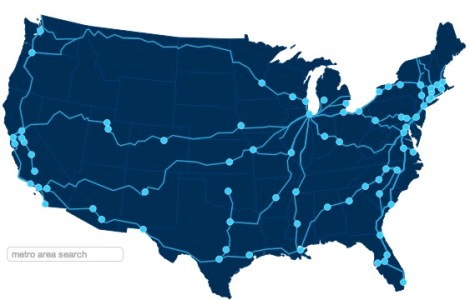If you’ve been on an Amtrak train lately with crappy snacks, non-working power outlets, and faulty wifi, you might not agree with the claim that “American passenger rail is in the midst of a renaissance.” But that’s the word from the folks at the Brookings Institution, which has released a new report detailing how Amtrak is “well-positioned for the future” after seeing massive growth over the last 15 years. Growth in ridership, that is, not in service.
“Ridership grew by 55 percent since 1997 and is now at record levels, with over 31 million travelers annually,” according to Brookings. “That’s faster than other travel modes like aviation and far outpaces the growth in population and economic output during that time.” The study also found that 100 of the country’s biggest metro areas are responsible for almost 90 percent of Amtrak’s ridership, with 10 of those making up almost two-thirds of it.
Brookings has a sweet interactive map with data about Amtrak routes nationwide, with a focus on some of those most train-crazy big cities, and a look at which are the cheapest and most expensive rides in terms of operating costs. Here’s a static version:
Compare, though, Brookings’ map to this map showing how much the U.S. passenger rail network has shrunk since 1962, and that “renaissance” looks a little less golden.

Brookings’ takeaway is that passenger rail has grown in accordance with municipal and state partnerships:
States now share the operating costs for short-distance rail corridors that stretch 750 miles or less from end to end. Today, these routes are Amtrak’s high-performers, carrying around 85 percent of travelers.
Importantly, once they have “skin in the game,” states are motivated to target investments more precisely and develop plans more comprehensively, better tailoring maintenance needs and capital improvements to local demands. Some states have already adopted such strategies and offer innovative and replicable models. …
Building on this new federal-state alignment will require additional action. As the federal sequestration battle clearly illustrates, Washington isn’t putting any new money into Amtrak anytime soon. But partly because of the existing partnerships with 15 states, Amtrak has said it can weather the cuts easily enough.
So let’s extend that requirement for state support to routes longer than 750 miles. After all, our research shows that the long-distance routes carried only 15 percent of the travelers in 2012 but, combined, constitute 43 percent of Amtrak’s route-associated operating costs. This is not just a matter of offloading responsibility from the federal government to states. As seen in the short-distance routes that already enjoy state support, such a partnership results in a better sharing of risks and rewards.
Brookings says the goal is to “strengthen passenger rail in the United States by strengthening the federal-state partnership.” The U.S. would still have a long way to go before it became as train-crazy as many European countries, but this might be a start.





